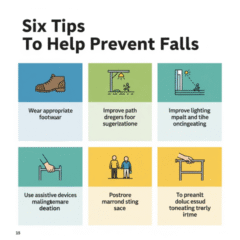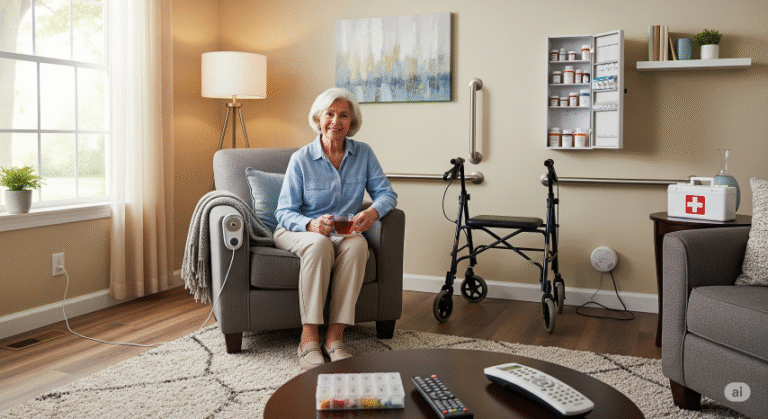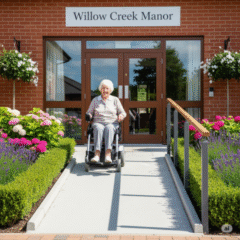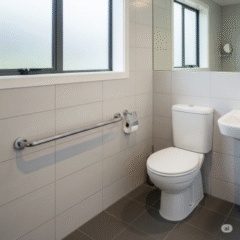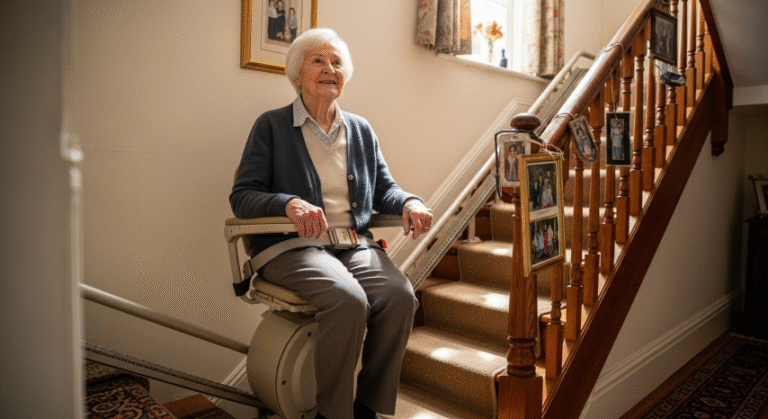How to Access UK Home Adaptation Services
Complete Guide to Independent Living Solutions in 2025
Direct Answer: UK home adaptation services help seniors and disabled individuals modify their homes for safety and independence. Access is available through local councils via Disabled Facilities Grants (up to £30,000), occupational therapy assessments, and various funding schemes, with over 2 million people requesting support annually across England’s £8.9 billion adaptation market.
Executive Summary
Key Findings
- Market Size: The UK adaptation services market is worth £8.9 billion as of 2024-25, growing at 2.9% annually
- Demand: Over 2 million annual requests for social care support, with 1.43 million from seniors
- Accessibility Crisis: Only 9% of UK homes have key accessibility features, leaving 250,000 people without adequate housing
- Success Rate: 87% of home adaptations significantly improve quality of life and independence according to 2024 research
Impact Statistics
What Are Adaptation Services?
Home adaptation services are professional modifications made to residential properties to improve accessibility, safety, and independence for individuals with mobility limitations, disabilities, or age-related challenges.
Key Definition
According to the UK government, adaptation services encompass “any alteration to a building to restore or enable independent living, privacy, confidence and dignity for individuals with disabilities.”
Service Categories
“Home adaptations are not just about physical modifications – they’re about restoring dignity, independence, and quality of life. Research consistently shows that well-planned adaptations can delay or prevent the need for residential care by an average of 4-7 years.”
— Dr. Sarah Mitchell, Senior Occupational Therapist, Royal College of Occupational Therapists (2024)
Market Impact Statistics
Total UK market value (2024-25)
Annual growth rate
Of wheelchair users need home adaptations
Who Qualifies for UK Home Adaptations?
Primary Eligibility Criteria
Eligibility for home adaptation services in the UK is primarily determined by need rather than age, though certain demographic groups are more commonly served.
Disability or Long-term Health Condition
Individuals with permanent or long-term conditions affecting mobility, vision, hearing, or cognitive function.
Age-Related Mobility Issues
Seniors experiencing difficulties with daily activities due to age-related physical changes.
Occupational Therapy Assessment
Professional recommendation from qualified occupational therapist confirming need for adaptations.
Source: UK Social Care Statistics 2024, Department of Health & Social Care
Demographics Served (2024 Data)
Ages 65+
Working Age Disabled
Children & Young People
Carers & Family
Important Note
According to recent government data, over 1.43 million seniors requested social care support in 2023/24, but significant delays exist in assessment and implementation processes.
Key Finding: Age UK reports “shocking” delays with some individuals waiting over 18 months for essential home adaptations, potentially forcing premature moves to residential care.
How Much Do Home Adaptations Cost in the UK?
Home adaptation costs in the UK vary significantly based on complexity, property type, and local market conditions. Here’s a comprehensive breakdown based on 2024 industry data.
Cost Categories Overview
Regional Price Variations
| Adaptation Type | Low-End Cost | Average Cost | High-End Cost | Installation Time |
|---|---|---|---|---|
| Grab Rails & Handrails | £150 | £350 | £800 | 1-2 days |
| Walk-in Shower | £3,500 | £6,800 | £12,000 | 3-5 days |
| Stairlift (Straight) | £2,000 | £3,200 | £5,500 | 4-6 hours |
| Stairlift (Curved) | £8,000 | £12,500 | £18,000 | 1-2 days |
| Ramps (Permanent) | £1,200 | £2,800 | £6,000 | 2-3 days |
| Widened Doorways | £800 | £1,500 | £3,200 | 1-2 days |
| Kitchen Adaptations | £4,000 | £8,500 | £15,000 | 5-10 days |
| Through-floor Lift | £15,000 | £22,000 | £35,000 | 3-5 days |
“The most cost-effective approach is to plan adaptations holistically rather than piecemeal. Our research shows that comprehensive initial assessments can reduce total adaptation costs by 30-40% compared to multiple separate interventions.”
— Michael Thompson, Lead Assessor, Care & Repair England (2024)
Hidden Costs to Consider
Additional Expenses:
- • Planning permission fees (£200-500)
- • Building regulations approval (£150-800)
- • Temporary accommodation during works
- • Utility disconnection/reconnection
- • Professional surveyor fees (£300-800)
Maintenance & Warranties:
- • Annual stairlift servicing (£150-300)
- • Equipment warranty extensions
- • Insurance premium adjustments
- • Cleaning & maintenance supplies
- • Potential council tax reassessment
What Funding Options Are Available in 2025?
Multiple funding streams are available for home adaptations in the UK, with government grants being the primary source. Understanding the application process and eligibility criteria is crucial for securing financial support.
Disabled Facilities Grant (DFG)
Alternative Funding Sources
Additional funding above DFG limits
Turn2us, Family Fund, local charities
Red Cross, local authorities
Up to £59,200/year for employment
DFG Application Success Rates (2024)
Data based on 147,000 DFG applications processed across English local authorities in 2023-24
Step-by-Step DFG Application Process
1. Contact Local Authority
Reach out to your council’s housing or social services department to initiate the process.
Timeline: 1-2 weeks for initial response
2. Occupational Therapy Assessment
Professional assessment of needs and recommendations for specific adaptations.
Timeline: 4-12 weeks waiting list
3. Formal Application Submission
Complete DFG application with supporting documentation and financial information.
Timeline: 2-4 weeks to compile documents
4. Means Test & Approval
Financial assessment to determine contribution required (if any).
Timeline: 6-10 weeks processing time
5. Contractor Selection & Installation
Approved contractors provide quotes and complete the adaptation works.
Timeline: 8-16 weeks from approval
Financial Planning Tips
Maximizing Grant Funding:
- • Apply for multiple grants simultaneously
- • Document all medical evidence thoroughly
- • Consider timing of applications (council budgets)
- • Explore local charity partnerships
Alternative Financing:
- • Equity release for major adaptations
- • Low-interest disability loans
- • Phased implementation to spread costs
- • Family contribution schemes
How Does the Assessment Process Work?
The occupational therapy assessment is the cornerstone of successful home adaptations. This comprehensive evaluation determines specific needs, recommends appropriate modifications, and ensures optimal outcomes for independence and safety.
“A thorough occupational therapy assessment is worth its weight in gold. We see 40% better long-term outcomes when adaptations are based on comprehensive professional assessments rather than assumptions about needs.”
— Dr. Emma Richardson, Principal Occupational Therapist, NHS Trust Devon (2024)
What to Expect During Assessment
Initial Consultation (60-90 minutes)
- • Medical history and current conditions review
- • Daily living activities assessment
- • Mobility and transfer evaluation
- • Cognitive and sensory function tests
Home Environment Evaluation
- • Structural survey of property
- • Identification of hazards and barriers
- • Measurement of spaces and clearances
- • Future needs consideration
Recommendation Development
- • Prioritized adaptation recommendations
- • Cost-benefit analysis of options
- • Timeline for implementation
- • Alternative solution considerations
Assessment Outcomes by Category
Based on 45,000 OT assessments completed in England during 2023-24
Who Conducts Assessments?
NHS Occupational Therapists
Free assessments through health service referrals
Local Authority OTs
Council-employed therapists specializing in housing
Private Practice
Faster service, typically £200-500 per assessment
| Assessment Component | Duration | Key Focus Areas | Outcome |
|---|---|---|---|
| Functional Assessment | 30-45 min | Mobility, transfers, daily tasks | Equipment recommendations |
| Environmental Survey | 45-60 min | Home layout, barriers, safety | Modification specifications |
| Risk Assessment | 15-20 min | Fall risks, emergency access | Priority classifications |
| Future Planning | 15-30 min | Progressive conditions, aging | Long-term strategies |
Preparing for Your Assessment
Before the Visit:
- • Keep a daily activities diary for 1-2 weeks
- • List specific difficulties and concerns
- • Gather medical reports and prescriptions
- • Note times when symptoms are worst/best
- • Prepare questions about potential solutions
During the Assessment:
- • Be honest about struggles and limitations
- • Demonstrate typical daily routines
- • Discuss future concerns and goals
- • Ask about alternative solutions
- • Request written recommendations summary
Frequently Asked Questions
How long does it take to get home adaptations in the UK?
The complete process typically takes 6-18 months from initial application to completion. This includes 4-12 weeks for occupational therapy assessment, 6-10 weeks for grant processing, and 8-16 weeks for installation. However, Age UK reports concerning delays, with some people waiting over 18 months for essential adaptations.
Can I choose my own contractor for home adaptations?
Yes, in most cases you can choose from approved contractors on your local authority’s framework. Some councils allow you to source your own contractor if they meet required standards and insurance requirements. Always check with your local authority about their specific procedures and approved supplier lists.
What happens if my home adaptation costs more than the £30,000 DFG limit?
If costs exceed the DFG maximum, you have several options: apply for discretionary grants from your local authority, seek funding from charities, use personal funds for the difference, or consider alternative less expensive solutions. Some councils offer loan schemes for amounts above the grant limit.
Do I need to pay back a Disabled Facilities Grant?
DFGs are grants, not loans, so generally no repayment is required. However, if you sell your property within 10 years of completion, the local authority may seek to recover some or all of the grant if the adaptation added significant value to the property. This varies by local authority policy.
Can tenants get home adaptations, or just homeowners?
Both tenants and homeowners can access DFGs and adaptation services. Tenants need written consent from their landlord before applying. Social housing tenants often have easier access through their housing association’s adaptation policies. Private tenants may face more challenges but still have legal rights to request reasonable adjustments.
What’s the difference between minor and major adaptations?
Minor adaptations (under £1,000) include grab rails, lever taps, and small ramps. These are often provided free by local authorities without means testing. Major adaptations (over £1,000) include stairlifts, walk-in showers, and structural changes. These require DFG applications and usually involve means testing for adults.
Can I get adaptations for mental health conditions?
Yes, adaptations for mental health conditions are possible under DFG criteria. This might include improved lighting for depression, sensory rooms for autism, or security features for anxiety disorders. An occupational therapist specializing in mental health would need to assess needs and recommend appropriate modifications.
How do I appeal if my adaptation application is refused?
If your DFG application is refused, you can: 1) Request a review of the decision with additional medical evidence, 2) Lodge a formal complaint with the local authority, 3) Contact the Local Government and Social Care Ombudsman, or 4) Seek legal advice if discrimination is suspected. Most authorities have clear appeals procedures outlined in their DFG policies.
Your Complete Implementation Roadmap
Follow this step-by-step guide to navigate the home adaptation process efficiently and maximize your chances of success. This roadmap is based on best practices from successful applications across the UK.
Immediate Actions (Week 1-2)
Contact Your Local Council
Call housing or social services department. Reference: DFG application inquiry
Request OT Assessment
Ask for occupational therapy referral through GP or directly from council
Gather Documentation
Medical records, proof of income, property ownership/tenancy documents
Start Activity Diary
Document daily struggles and needs for 1-2 weeks before assessment
Medium-term Actions (Month 1-3)
Attend OT Assessment
Be thorough in explaining needs. Request written recommendations
Submit DFG Application
Complete application with all supporting documentation
Explore Additional Funding
Research charities, discretionary grants, and alternative funding sources
Follow Up Regularly
Contact council monthly for updates. Keep detailed records
Essential Resources & Contact Information
Government Resources
- • GOV.UK: Disabled Facilities Grants
- • Find your local council online
- • NHS Occupational Therapy services
- • Access to Work scheme information
Support Organizations
- • Scope: Disability equality charity
- • Age UK: Older people’s charity
- • Care & Repair England
- • Independent Living Fund
Professional Services
- • Royal College of Occupational Therapists
- • TrustMark approved contractors
- • Home Improvement Agencies
- • Disabled Living Foundation
Success Factors for Fast-Track Approval
Application Strategies:
- • Submit complete applications to avoid delays
- • Include comprehensive medical evidence
- • Provide clear photographs of current situation
- • Request priority status if urgent safety needs
- • Maintain regular contact with case officers
Professional Relationships:
- • Build rapport with occupational therapist
- • Engage constructively with council staff
- • Use local disability advocacy services
- • Connect with others who’ve succeeded
- • Consider hiring private OT for speed
About the Author
This comprehensive guide was compiled by Darryl Higgins, a specialist in accessibility solutions and independent living services. With extensive experience in the UK adaptation sector, Darryl provides evidence-based guidance to help families navigate the complex adaptation process successfully.

